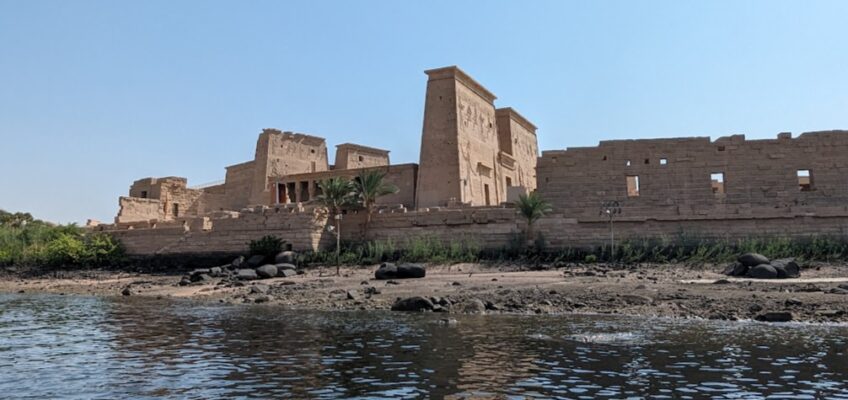The highlight of our visit to Aswan was our visit to Philae Temple. There were other things I have to write about, especially the hotel where we stayed. And I have some back story to share.
The Old Cataract Hotel
The drive from Abu Simbel back to Aswan somehow felt longer and bumpier than the ride down there. But we finally arrived and checked into our hotel the Old Cataract. This was probably the nicest hotel I’ve ever stayed at. Plus, as a frequent traveler with OAT, I got upgraded to a suite. It was just stunning. The downside is when I put something down somewhere, I couldn’t remember where to find it!
The view from my balcony was amazing.
Aswan Market
The first evening we made a visit to the Aswan Market. As has been common wherever things are being sold in Egypt, the vendors were pushy and persistent, walking right in front of you to show you their products, and repeatedly saying “hello” or “excuse me” to get you to stop and look at what they’re selling.
There were a few nice shops, but I didn’t buy anything.
Philae
The next morning we headed by boat to Philae Island to visit the temple there. This is one of the twelve temples that were relocated when the High Dam was built. It was always on an island, but now it’s on an island that is higher.
The story
When we arrived at the temple, Mo shared some mythology about the gods and goddesses whose stories are reflected in the carvings at Philae Temple. As he told us, the stories vary somewhat from one telling to another, but essentially, there are nine gods, the Ennead, who were at the top of the hierarchy.
Amun, or Ra, was the ancient god of creation. These two gods merged over time to become Amun-Ra. Because he was the only god, he impregnated himself and gave birth through his mouth to twins, Shu and Tefnut. Shu was the god of air; Tefnut was the goddess of water.
Shu and Tefnut had two children, the earth god Geb and the sky goddess Nut.
Get and Nut, in turn, had four children: Osiris, Isis, Set, and Nephtys. Osiris was the god of the afterlife and resurrection. Isis was the goddess of life and magic. Set was the god of chaos, anger, deceit, destruction, and war. And Nephtys was the goddess of death and the night.
Osiris and Isis were married. Osiris was the first divine king of Egypt. Set was jealous of Osiris and tricked him into entering a magical casket. Set then threw the casket into the Nile, and Osiris died. But Isis eventually found him and resurrected him.
When Set learned of this, he cut Osiris into fourteen pieces and scattered them all over the earth. Isis found thirteen of the fourteen pieces. The fourteenth, Osiris’ penis, was eaten by a fish. She put him back together and resurrected him for a second time. Then she made a penis out of mud, and she became pregnant and gave birth to Horus, the falcon-god. Eventually Horus killed Set to avenge his father’s two murders.
The Temple
Philae Temple was built during the reigns of Ptolemy II and Ptolemy III, in the third century BCE. Some parts were added by later Ptolemies. Cleopatra, the last pharaoh, came here; we know because her cartouche is engraved on several columns. The Roman emperors Augustus and Tiberius (27 BCE-37 CE) contributed some of the decorations. And Hadrian, who reigned from 117 to 138 CE, added a gate west of the complex.
C (symbol at the top
L (lion)
E (feather)
O (loop or sperm-like symbol)
P (small square)
A (eagle)
T (hand)
R (next symbol)
A (another eagle)
Here are all my photos from Philae Temple.
And here are all my photos from Aswan.
This afternoon I fly to Jordan to conclude my abbreviated trip. I’ll be back with more soon.


Leave a Reply